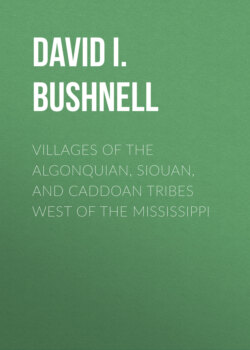Villages of the Algonquian, Siouan, and Caddoan Tribes West of the Mississippi

Реклама. ООО «ЛитРес», ИНН: 7719571260.
Оглавление
David I. Bushnell. Villages of the Algonquian, Siouan, and Caddoan Tribes West of the Mississippi
Villages of the Algonquian, Siouan, and Caddoan Tribes West of the Mississippi
Table of Contents
PREFACE
ILLUSTRATIONS
TEXT FIGURES
VILLAGES OF THE ALGONQUIAN, SIOUAN, AND CADDOAN. TRIBES WEST OF THE MISSISSIPPI
By David I. Bushnell, Jr
THE TRIBES AND THEIR HABITAT
THE BUFFALO
(Bison americanus.)
VILLAGES AND FORMS OF STRUCTURES
Algonquian Tribes
ojibway
cree
cheyenne
blackfoot confederacy
arapaho
sauk and foxes
illinois
Siouan Tribes
dakota-assiniboin group
Mdewakanton
Wahpeton
Yanktonai
Yankton
Teton
OGLALA
Assiniboin
dhegiha group
Omaha
Ponca
Kansa
Osage
Quapaw
chiwere group
Iowa
Oto
Missouri
winnebago
mandan
hidatsa group
Hidatsa
Crows
Caddoan tribes
pawnee
arikara
wichita
Waco
caddo
CONCLUSION
AUTHORITIES CITED
SYNONYMY
EXPLANATION OF PLATES
Plate 1
Plate 2
Plate 3
Plate 4
Plate 5
Plate 6
Plate 7
Plate 8
Plate 9
Plate 10
Plate 11
Plate 12
Plate 13
Plate 14
Plate 15
Plate 16
Plate 17
Plate 18
Plate 19
Plate 20
Plate 21
Plate 22
Plate 23
Plate 24
Plate 25
Plate 26
Plate 27
Plate 28
Plate 29
Plate 30
Plate 31
Plate 32
Plate 33
Plate 34
Plate 35
Plate 36
Plate 37
Plate 38
Plate 39
Plate 40
Plate 41
Plate 42
Plate 43
Plate 44
Plate 45
Plate 46
Plate 47
Plate 48
Plate 49
Plate 50
Plate 51
Plate 52
Plate 53
Plate 54
Plate 55
INDEX
Отрывок из книги
David I. Bushnell
Published by Good Press, 2021
.....
Two very interesting old photographs, made more than half a century ago, are shown in plate 9. One, a, represents clearly the elm-bark covering of the wigwams, and in this picture the arbor suggests a Siouan rather than an Ojibway encampment; b is more characteristic of the Ojibway.
The structures encountered in the Ojibway country farther south differed from those already mentioned, the majority of which were covered with sheets of birch bark, a form which must necessarily have been restricted to the northern country. But the type was widely scattered northward, and undoubtedly extended eastward to the Atlantic, especially down the valley of the St. Lawrence into northern Maine and the neighboring Provinces. South of this zone were the dome-shaped mat or bark covered wigwams, varying in different localities according to the available supply of barks, or of rushes to be made into mats, which served to cover the rigid, oval-topped frame. Most interesting examples were standing in the Ojibway settlements on the shore of Mille Lac, Minnesota, during the spring of 1900. One, which may be accepted as a type specimen, was of a quadrilateral rather than oval outline of base, and measured about 14 feet each way, with a maximum height of 6 feet or more. The saplings which formed the frame were seldom more than 2 inches in diameter, one end being set firmly in the ground, the top being bent over and attached to similar pieces coming from the opposite side. Other small saplings or branches were tied firmly to these in a horizontal position about 2 feet apart, thus forming a rigid frame, over which was spread the covering of mats and sheets of bark, the latter serving as the roof. In this particular example the covering was held in place by cords which passed over the top and were attached to poles which hung horizontally about a foot above the ground. A second row of mats was fastened to the inside of the frame and others were spread on the ground near the walls. A small fire burned within near the center of the open space, although the cooking was often done outside, just beyond the single entrance.
.....